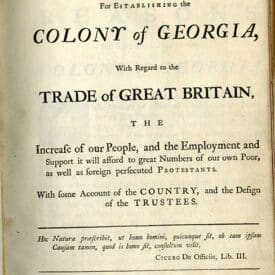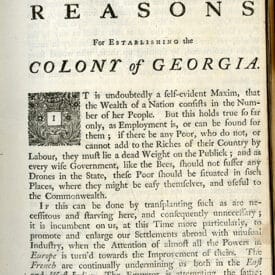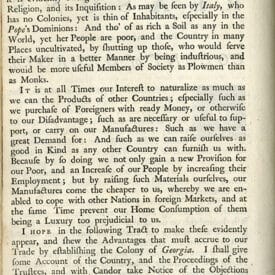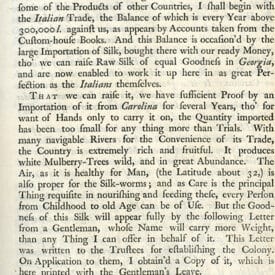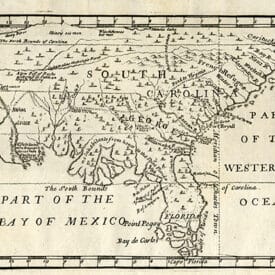Oglethorpe as a Georgia Trustee
Founding the Georgia Trustees
When Oglethorpe was 33, his friend Robert Castell was jailed because of his debts. While in prison, Castell caught smallpox and died, which caused Oglethorpe to begin to look into prison conditions in England. At this time, Oglethorpe was a member of Parliament, and because of his interest, he was named the chairman of a parliamentary committee to investigate the English prison system. During their investigation, Oglethorpe and the other committee members discovered that prisoners were often jailed like Robert Castell because they could not pay their debts, and once in jail were subjected to terrible conditions.
Oglethorpe saw the injustice of the situation and was further horrified by the abuses and dismal conditions prisoners endured in the prisons. He began speaking out against them, gaining national attention, and people started to recognize him as a humanitarian for trying to change a system that so mistreated people. Because of the attention on debtor’s prison and poor people in England, Oglethorpe and several others from the parliamentary committee to investigate prisons looked even deeper into the plight of poor people in England. They were inspired to create a new colony in America to give the poor a chance to succeed as farmers, merchants, and artisans.
Through his work on prison reform, Oglethorpe met Dr. Thomas Bray, the founder of the Society for the Propagation of the Gospel in Foreign Parts and the Society for Promoting Christian Knowledge. Bray left £5,000 for the administrators of his estate, including Oglethorpe, to use for good works in the colonies. Some of this group of administrators, called Associates of Dr. Bray, would go on to become Trustees of Georgia.
In 1730, the Associates of Dr. Bray petitioned Parliament for a charter to form the 13th colony in America. It took some time for Parliament to act on the request. Prime Minister Robert Walpole was hesitant to place a colony below South Carolina, fearing it would provoke the Spanish in Florida who already had a stake in the area. After gaining support among members of Parliament, some changes were made to the charter so “the deserving poor” would be sent to Georgia, instead of the original idea of sending debtors from prison. The deserving poor were people who would be chosen by the Trustees because they could bring skills to the new colony to help the whole community and have a chance at success in the new world at the same time.
In promotional material, the Georgia Trustees focused on three reasons for founding the colony: philanthropy, economics, and defense. The new colony offered a new start for England’s “deserving poor” in a society structured on hard work, equality, and morality. Economically, the new colony would produce raw materials at a cheap price. The Trustees invested most in silkworm farming. Silkworms feed on mulberry leaves and produce a cocoon made of silk, a valuable product used to make fine fabrics. The Trustees official seal even featured the mulberry leaf, silkworm, and cocoon. In addition to philanthropy and economics, the Georgia Trustees also promoted the new colony as a defensive barrier between Spanish Florida and English South Carolina.
In April 1732, two years after originally submitting the charter to Parliament, King George II signed the charter to create the colony and create the Trust, the governing body of the colony. The Trust was a corporate entity and allowed for a governing body of Trustees to serve and govern Georgia from England. In July 1732 the Trustees met for the first time and set about looking for contributions to fund the colony and people to populate it. Five months later the Trustees saw Oglethorpe and the colonists off as they embarked on their journey to the colonies.
Georgia’s Trustee Period
Unlike colonies led by royal governors, like South Carolina’s Governor Johnson, Georgia was governed by the Trustees until 1752. Oglethorpe fulfilled the role of leader and governor for a time when the settlers reached the new colony, but he eventually had to focus on defending Georgia and South Carolina from the Spanish. Georgians had to rely on the officials the Trustees appointed from England to maintain authority.
The Trustees ruled Georgia for 21 years, but the only Trustee who ever stepped foot in the colony was General Oglethorpe. Oglethorpe spent ten years in Georgia until he returned to England for good in 1744. He continued on as Trustee for some years, but eventually the other Trustees began allowing practices such as slavery that Oglethorpe opposed and he withdrew from the organization. In 1752 the Trustees turned Georgia over to the king, ending Trustee Georgia and beginning Royal Georgia.
From the Source
In 1733, the Georgia Trustees published a pamphlet titled “Reason’s for Establishing the Colony of Georgia.” The publication is an example of promotional literature used by the trustees to entice British subjects to donate money to the cause of the colony and consider emigrating. The gallery below features images from the Georgia Historical Society’s copy. You can read the full text in Collections of the Georgia Historical Society, Volume I.

